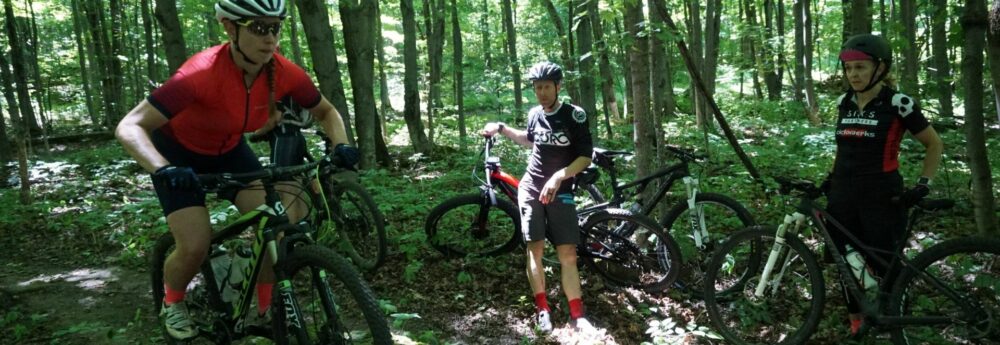Concussions have been interesting to me for several years for both personal and professional reasons. This article is meant to put together some of the learning I have had over the years, as well as more recently with enhanced concussion education in Ontario and through working through concussions with my coaching clients.
I have sustained many head injuries in my life but I have been fortunate not to experience symptoms beyond perhaps 24 hours at most. I do spend time wondering about long term consequences, given findings around frequent impacts and football.
Beyond my own head injuries, I interact with many cyclists and athletes each year through my coaching, skill sessions, training-camps, and races. It strikes me that more cyclists are experiencing these prolonged symptoms after a head injury (called post-concussion syndrome). It is possible we are all more aware of the risks of head injury or that we are seeing more participation at higher levels by people with existing risk factors for post-concussion syndrome. This interesting study from 1992 describes the condition and some of the controversy around it. These symptoms are quite debilitating and, while ‘invisible’ from the outside, can be life-changing for those affected and their loved ones.
I wrote this article in 2015 talking about things I felt like we might do to reduce crashes in general. I wrote about risk-taking and gradual exposure because I felt like some of the injuries (at the time and in my estimation) were happening in younger athletes, especially females, quite frequently. I surmised that these young athletes were being forced to catch up to the new, technical features on ‘Olympic cross country’ courses and that athletes and coaches were taking undue risks by rushing proper progression and not analyzing the risk: reward adequately.
What is a Concussion?
“A concussion is a brain injury that *can’t* be seen on x-rays, CT or MRI scans. It affects the way an athlete thinks and can cause a variety of symptoms.” (page 29 in the Canadian guidelines)
WHAT CAUSES A CONCUSSION?
“Any blow to the head, face or neck, or somewhere else on the body that causes a sudden jarring of the head may cause a concussion. Examples include getting body-checked in hockey or hitting one’s head on the floor in gym class” (page 29 in the Canadian guidelines)
In cycling, we might suspect this with any dents, scrapes or dirt on the helmet and certainly with any injury to the face. Remembering that we do not need to hit the head but also might experience extreme forces (think whiplash or sudden stops) and so if there is a crash it is likely wise to stop training for the day.
What to Do If You Suspect a Head impact
Recognize and act – this is a quick guide to knowing when to call for an ambulance versus remove from play. The guide includes questions to ask and symptoms to watch for.
Follow these three steps if you — or someone you know — experiences a blow to the head, face, neck or body and you suspect a concussion. Call 911 if you are concerned the injury is life-threatening, such as the person is unconscious or they had a seizure.
1) Recognize signs and symptoms of a concussion and remove yourself or the athlete from the sport/physical activity, even if you feel OK or they insist they are OK.
2) Get yourself or the athlete checked out by a physician or nurse practitioner.
3) Support gradual return to school and sport.
https://www.ontario.ca/page/rowans-law-concussion-awareness-resources#section-2
Mistakes I keep seeing
In the last year when I have seen more males and masters aged clients getting concussions with lasting symptoms and it seems that with a very high frequency the following two overarching rules are not followed:
- Stop playing if you hit your head (or crash as per above). This may mean calling for a ride home or not finishing a race or group ride.
- Don’t do much, if anything, including work/screens/exercise in the 24 hours after the head impact. Don’t go ‘test’ your body/brain out in that period. It isn’t a bad idea to go to the doctor!
Return to Sport / Work
Essentially you have a 24-48 hour period of low to no symptoms with no activity (typically you would get medical clearance from a doctor), the first step, which is detailed in the below return to sport link, is to do some light activity around the home, if symptoms do not worsen in the next 24 hours then you might progress to something like indoor cycling for 10 min at a very light exertion (low recovery zone) and again wait 24 hours before progressing to the next level, which again will add volume, intensity or extra variables (other people, outdoors, offroad etc.)
When Recovery Takes Longer
Post Concussion Syndrome is when there are symptoms that persist for weeks, months and even years after the initial injury. Below is a quote from a client whom I coach who dealt with symptoms for several months after a concussion.
“I think that two of the lessons that I’ve learned that I would not have known before are that every concussion is unique. It’s unique between people […] So healing takes its own path and is not linear. That was very challenging to wrap my head around. Secondly, for many people the expectations need to change from days to weeks and months and sometimes even years. It’s easy to say these words, but living through the pace of healing is extremely frustrating and patience is so critical. “
Should you experience prolonged recovery it is worth asking (and asking again) about options to be assessed for neck musculature, vestibular/vision dysfunction and other possible causes/factors in a prolonged recovery. This can be missed if you are with a practitioner not familiar with the latest concussion protocols and strategies. (more here)
- Return to Work and sport LINK => https://www.ontario.ca/page/ontario-government-concussion-awareness-resource-e-booklet-ages-15-and-up#section-5
- Great resource from SunnyBrook and Parachute on Post Concussion symptoms and return to sport/work
In Ontario, the concussion protocols have been formalized and mandated by the Ontario government. Anyone working with athletes under 25 likely needs to confirm their understanding of the protocol and submit a document to their sports organization. Really anyone in sport should review this up to date information on what a concussion is and how to deal with one when it happens both immediately and when symptoms persist.
- Resources offered via ‘Rowan’s Law’ In Ontario (which Ontario Coaches need to review and sign off on – see here )
- Great resources via Parachute on Concussions and they can be found here
Thank you for reading!
Hopefully, this is a helpful compilation of links and summary of ideas, please let me know as this becomes outdated or if any information is not accurate!





